Chicxulub Impact
Impact glass and spherules in carbonateMineral or compound containing carbon and oxygen (i.e. calcium carbonate, CaCO3, calcite). Click on Term to Read More matrixFine grained primary and silicate-rich material in chondrites that surrounds chondrules, refractory inclusions (like CAIs), breccia clasts and other constituents. Click on Term to Read More
Beloc, Haiti site
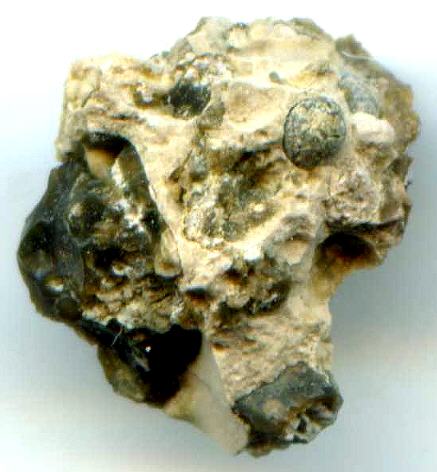
Recognized in 1990
18° 22′ 37′ N., 72° 35′ 22′ E., approx. A severe impact by a carbonaceous chondritic asteroid or long-period cometComets with orbital periods longer than 200 years, often with highly elliptical orbits highly inclined to the ecliptic. These comets probably were perturbed from orbits in the Oort cloud by a passing star or giant molecular cloud, or by tidal forces generated by the bulge and disk of our Galaxy. Click on Term to Read More (e.g., Moore and Sharma, 2013; Goderis et al., 2013; Durand-Manterola and Cordero-Tercero, 2014) occurred 66.038 (±0.011) m.y. ago as determined by Ar–Ar chronometry, and is likely associated with a major extinctionIn astronomy, the dimming of starlight as it passes through the interstellar medium. Dust scatters some of the light, causing the total intensity of the light to diminish. It is important to take this effect into account when measuring the apparent brightness of stars. The dark bands running across portions Click on Term to Read More event. This period marks the Cretaceous–Paleogene (K–Pg; formerly K–T) boundary separating the Mesozoic Era (age of dinosaurs) and Cenozoic Era (age of mammals). The size of the impactor was calculated to be at least 10 km (~6 mi) in diameter and to have conveyed at least 1.3 yottajoules (1024) of energy (Durand-Manterola and Cordero-Tercero, 2014), equivalent to ~6 million ‘Tsar Bomba’ nuclear devices. The impactor had a trajectory towards the southwest at an angle of ~60° (Collins et al., 2017), which created a multi-ring craterBowl-like depression ("crater" means "cup" in Latin) on the surface of a planet, moon, or asteroid. Craters range in size from a few centimeters to over 1,000 km across, and are mostly caused by impact or by volcanic activity, though some are due to cryovolcanism. Click on Term to Read More ~180 km (112 mi) in diameter known as Chicxulub crater—now buried under ~1 km of Tertiary sediments in the Yucatán Peninsula, Mexico. Updated hydrocode models indicate that the impact into ~545 m.y.-old granitic to gneissic basement rock, which was overlain by carbonates, black shales, and evaporites, ejected 325 (±130) Gt of sulfur and 425 (±160) Gt of CO2 into the atmosphere at velocities >1 km/s; these climate-active gases ultimately reached altitudes >25 km (Artemieva et al., 2017). An even greater volume of CO2 may have been additionally released globally during re-entry of ~12,000 Gt of sedimentary carbonate rock ejectaFractured and/or molten rocky debris thrown out of a crater during a meteorite impact event, or, alternatively, material, including ash, lapilli, and bombs, erupted from a volcano. Click on Term to Read More (Artemieva and Morgan, 2018). An improved climate model suggests that the reductionOxidation and reduction together are called redox (reduction and oxidation) and generally characterized by the transfer of electrons between chemical species, like molecules, atoms or ions, where one species undergoes oxidation, a loss of electrons, while another species undergoes reduction, a gain of electrons. This transfer of electrons between reactants Click on Term to Read More in solar irradiation due to sulfate aerosols led to a decrease in global annual average surface air temperatures by at least 26°C (79°F)—the tropics experienced a decrease from 27°C (81°F) to 5°C (41°F) that lasted for up to 16 years (Brugger et al., 2017). 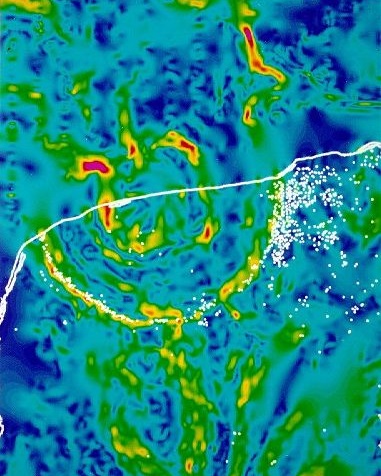
Bouguer gravityAttractive force between all matter - one of the four fundamental forces. Click on Term to Read More anomaly map of Chicxulub craterLarge (150-180 km wide and 20 km deep), partially submerged, multi-ringed impact crater straddling the northwest coastline of the Yucatan Peninsula in Mexico. It is named after a village located near its center (21° 20' N, 89° 30' W). The Chixculub Crater is believed to have formed 66 million years Click on Term to Read More
Image credit: Geological Survey of Canada
The white-dotted ring of cenotes (sinkholes) mark the subsurface structure of the crater rim. They were created by groundwater flow to the sea which dissolved ancient mineralInorganic substance that is (1) naturally occurring (but does not have a biologic or man-made origin) and formed by physical (not biological) forces with a (2) defined chemical composition of limited variation, has a (3) distinctive set of of physical properties including being a solid, and has a (4) homogeneous Click on Term to Read More deposits.
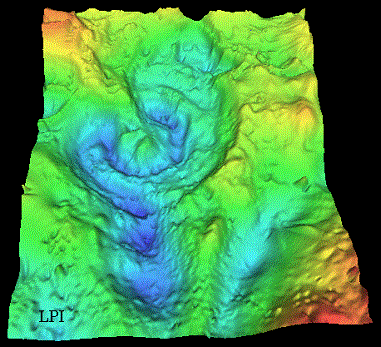
3-D geomagnetic image of Chicxulub crater
Image credit: V. L. Sharpton, LPI This impact produced lithologies such as polymict impact breccia and impact melt rock which were discovered in borehole samples obtained from the interior of the Chicxulub crater (David A. Kring, LPI, ‘Chicxilub Impact Event’). The impact event is associated with shocked quartz with planar deformation features, as well as impact-generated melt products in the form of sub-mm- to mm-scale glass spherules (microtektites) and irregularly- to aerodynamically-shaped glass shards and fragments, all embedded in an iridium-enriched astrostratigraphic unit identified at various locations around the world (e.g., Hildebrand and Boynton, 1990; Kring and Boynton, 1991). In addition, cubic nanodiamonds have been identified by investigators in North American K–Pg boundary layers, while Bunch et al. (2008) identified shock-produced hexagonal nanodiamonds (lonsdaleiteHexagonal polymorph of carbon (C) that forms from meteoric graphite during impact. The immense heat and stress of the impact transforms the graphite into diamond, but retains graphite's hexagonal crystal lattice (below). Lonsdaleite was first identified from the Canyon Diablo meteorite at Barringer Crater (also known as Meteor Crater) in Click on Term to Read More) in K–Pg boundary layers at Needles Point, New Zealand and Caravaca, Spain. Lonsdaleite is formed as carbonaceous material is subjected to extreme pressure (>15 GPa) and temperature (>1000°C).
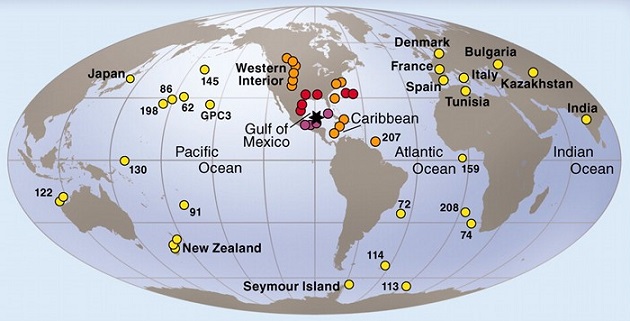
click on photo for a magnified view with explanatory information Global distribution map of key K–Pg boundary data locations
Image credit: Schulte et al. (2010)

Western Interior Seaway during its retreat 65 million years ago
Image credit: Dr. Ron Blakey of Colorado Plateau Geosystems, Inc. A fossil meteoriteThe textural, mineralogical or compositional remnant within a sedimentary rock of a meteorite that fell millions of years ago and found in Ordovician limestone from Sweden. Read Tiny Traces of a Big Asteroid Breakup for a complete writeup on this subject. In picture to the left a nautiloid shell is Click on Term to Read More measuring 2.5 mm in diameter that was recovered from K–Pg boundary sediments in the western North Pacific by the Deep Sea Drilling Project was classified as a probable CV, CO, or CR carbonaceous chondriteCarbonaceous chondrites represent the most primitive rock samples of our solar system. This rare (less than 5% of all meteorite falls) class of meteorites are a time capsule from the earliest days in the formation of our solar system. They are divided into the following compositional groups that, other than Click on Term to Read More, but a CM type was not excluded (Kyte, 1998). Results of a Cr-isotopic analyses conducted by Trinquier et al. (2006) indicate that a CM2 chondriteChondrites are the most common meteorites accounting for ~84% of falls. Chondrites are comprised mostly of Fe- and Mg-bearing silicate minerals (found in both chondrules and fine grained matrix), reduced Fe/Ni metal (found in various states like large blebs, small grains and/or even chondrule rims), and various refractory inclusions (such Click on Term to Read More was the most likely impactor type. Goderis et al. (2013) analyzed highly and moderately siderophile elementLiterally, "iron-loving" element that tends to be concentrated in Fe-Ni metal rather than in silicate; these are Fe, Co, Ni, Mo, Re, Au, and PGE. These elements are relatively common in undifferentiated meteorites, and, in differentiated asteroids and planets, are found in the metal-rich cores and, consequently, extremely rare on abundances and ratios from numerous K–Pg boundary ejecta layer sites at varying distances from the Chicxulub crater to help resolve the type of projectile involved in the impact event. They found Ir concentrations as high as 40 ppmParts per million (106). Click on Term to Read More, which is up to 2,000× that of mean continental crustal values; however, this is less than the maximum concentrations of 87 ppm reported previously (e.g., Claeys et al., 2002). Based on HSE concentrations and PGEElements with geochemical properties similar to Pt (platinum) including Ru, Rh, Pd, Os, Ir, and sometimes Au. These occur in nature in close association with one another and with Ni and Cu. They are among the least abundant of the Earth’s naturally occurring elements. Click on Term to Read More inter-element ratios, and in consideration of other processes and factors which might have been involved (e.g., post-depositional remobilization, fractionationConcentration or separation of one mineral, element, or isotope from an initially homogeneous system. Fractionation can occur as a mass-dependent or mass-independent process. Click on Term to Read More during vaporization/condensation, alteration and/or loss of PGE host phases, localized background contamination, loss of impactor component to space, etc.), a carbonaceous chondrite belonging to the CM–CO clan was determined to be the most likely parental source object for the Chicxulub impactor. The impact spherules from the K–Pg boundary stratigraphic section in Haiti were identified by Bohor and Glass (1995) as splash-form melt droplets (spheroids, ovoids, teardrops, dumbbells, rods, etc.), which constitute the lowermost of two separate and compositionally different ejecta layers present at various sites within ~4,000 km of the crater. This thick, white-colored lower claystone layer consists of Type 1 spherules which are now mostly hollow due to dissolution, and are composed of secondary palagonite/smectite. Type 1 spherules were part of a ballistic ejecta curtain that was transported within the cold atmosphere at shallow angles and rapidly quenched. Acceleration of these spherules was aided by shock-volatilization of carbonates (and sulfates) composing the target rock, rapidly releasing CO2 and explosively converting water into steam. Consequently, these spherules are mostly restricted to sites within the Western Hemisphere. The thinner, black-colored upper claystone layer contains solid, crystalline Type 2 spherules along with Ni-rich spinelMg-Al oxide, MgAl2O4, found in CAIs. and abundant shocked quartzComposed of SiO2, quartz is one of the silica group minerals most common in Earth's crust, but never found in meteorites as inclusions visible to the naked eye. Quartz in meteorites has been found in very small quantities in eucrites, other calcium-rich achondrites, and in the highly reduced E chondrites1. Click on Term to Read More. Type 2 spherules are direct condensates from the plume of vaporized impactor and target rock, and are highly enriched in Ir compared to Type 1 spherules. Type 2 spherules are not only found at Type 1 sites proximate to the crater, but also at more distal sites worldwide (e.g., Umbria-Marche region in Italy). After the impact, the molten Type 1 glass spherules were quenched upon deposition into coastal waters (e.g., prior to tectonic uplift above sea level in Haiti) and shallow lakes or swamps (e.g., in the Western Interior of North America), while at some sites they were concentrated through megatsunami action (e.g., Shell Creek, Alabama). Although most of the glass spherules are now devitrified and have been altered to secondary clay minerals such as smectite, the glass spherules found most recently in a 2-cm-thick layer at Gorgonilla Island, Columbia, are virtually unaltered and represent the most pristine K–Pg boundary spherules known.
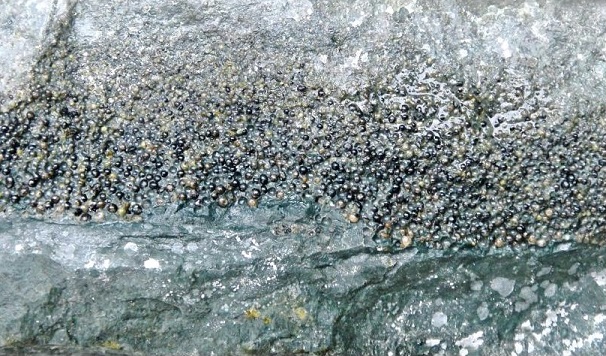
K–Pg boundary at Gorgonilla Island, Columbia, with well-preserved glass spherules up to 1.1 mm in diameter
Photo courtesy of Bermúdez et al., 2015
‘Discovery of a pristine Chicxulub impact glass spherule deposit on Gorgonilla Island, Colombia, in the Eastern Pacific Ocean’ The Haitian glass spherules typically have dacitic to andesitic compositions and are termed ‘black glass’, while the much less common ‘yellow glass’ spherules are high in Ca and S (Bohor and Glass, 1995). Yellow glass spherules were produced from an admixture of deep basement crystalline rock, from which the ‘black glass’ derives, and surface carbonate limestoneA common form of calcium carbonate (CaCO3). Other common forms of CaCO3 include chalk and marble. Click on Term to Read More (with <10% anhydrite component). Other glass samples have been found which exhibit intermediate compositional ranges between these two end member rock types, and the differences are attributed to formation under a very large range of oxidationOxidation and reduction together are called redox (reduction and oxidation) and generally characterized by the transfer of electrons between chemical species, like molecules, atoms or ions, where one species undergoes oxidation, a loss of electrons, while another species undergoes reduction, a gain of electrons. This transfer of electrons between reactants Click on Term to Read More conditions (Giuli et al., 2008). Similar to Libyan Desert GlassHigh-silica glass (SiO2) found in western Egypt near the Libyan border. The glass is often worn smooth due to aeolian sandblasting and ranges in color from milky white to the gem quality translucent yellow-green. The glass often contains small bubbles and lechatelierite. The origin of the glass is still disputed, Click on Term to Read More, some K–Pg boundary glasses contain the highly-shocked silicateThe most abundant group of minerals in Earth's crust, the structure of silicates are dominated by the silica tetrahedron, SiO44-, with metal ions occurring between tetrahedra). The mesodesmic bonds of the silicon tetrahedron allow extensive polymerization and silicates are classified according to the amount of linking that occurs between the phase lechatelieriteAn amorphous silica glass formed naturally by the heat of impact/detonation of a large meteorite on/over quartz sand. Lechatelierite is found as an inclusion in Libyan Desert Glass. Most commonly formed during lightning strikes in sand. Named for Henry Louis Le Chatelier (1850-1936), a French chemist. Click on Term to Read More along with other mineral inclusions (Koeberl and Sigurdsson, 1992). Furthermore, a meteoritic component was identified in a glass sample through Re–Os-isotopic analyses (Koeberl et al., 1994), and a very low water content (up to 0.021 wt%) indicative of an impact origin was reported in other glass samples (Koeberl, 1992). The extent of the known K–Pg exposure at the Shell Creek site in Wilcox County, Alabama is limited to ~200 m² near a narrow ford in the creek (King and Petruny, 2008). The stratigraphy of the K–Pg boundary section is 35–75 cm thick and consists of two distinct depositional layers. The basal gray–green-colored unit in direct contact with the upper Maastrichtian (Late Cretaceous) Prairie Bluff Chalk shelf is ~15–25 cm thick and is composed of Clayton Formation sand densely embedded with Type 1 impact spherules; hematiteFe-oxide mineral (Fe2O3) that may be the major cause of the red color on Mars. Coarser-grained gray hematite has the same chemical formula as the red variety, but a different crystalline structure. Deposits of gray hematite found in the Terra Meridiani region of Mars may suggest that water once circulated Click on Term to Read More has stained the lowermost few cm of this sand unit a reddish color. This basal unit is overlain by a tan-colored, more fine-grained, hummocky cross-laminated sand unit ~30–50 cm thick, which lies below lower Danian (Paleogene) sandy marls. The impact spherules at this site occur in a variety of splash forms (spheres, spheroids, dumbbells, teardrops, and others) in a size range of ~0.5–3 mm, the majority measuring slightly less than 1 mm. Similar to most other spherule-bearing sites, the impact spherules at Shell Creek have been altered to a nontronitic smectite shell with hollow interiors often filled by calcite (Ferrell et al., 2011); however, they still exhibit many fine details intrinsic to the primary glass phase. The differences that exist between the two sandstone units present at this site have been attributed to energetic wavePropagating disturbance which transmits energy from one point to another without physically transporting the oscillating quantity. A wave is characterized by wavelength and frequency. action involving tsunamis and/or strong cyclonic tropical storms.
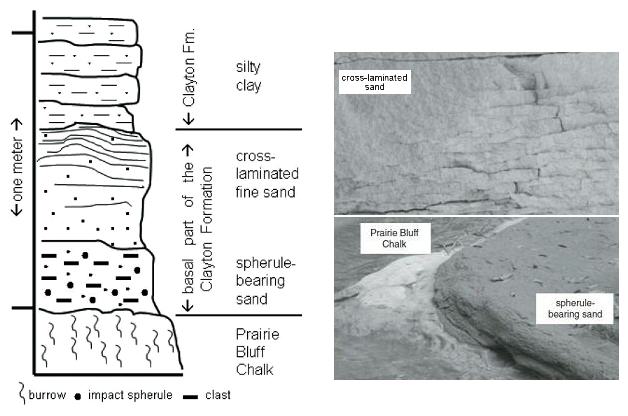
K–Pg boundary stratigraphic section at Shell Creek, Alabama (photos not shown to the same scale)
Diagram and photos courtesy of David T. King Jr. and Lucille W. Petruny, ‘The Sedimentary Record of Impacts’, GSA Special Paper 437, pp. 179–188 (2008) Excavations have been conducted near the northern-most extent of the alluvial plain of the Mississippi Embayment in southeastern Missouri. A K–Pg boundary stratigraphic section along the southeastern side of Crowley’s Ridge in Stoddard County, Missouri was described by Campbell et al. (2008) as situated between Upper Cretaceous Owl Creek Formation clay and lower Paleogene Clayton Formation glauconitic sandy clay. Splash form impact spherules representing morphologies and sizes similar to those from other Gulf Coastal K–Pg boundary sites such as Shell Creek, Alabama were identified in Owl Creek rip-up clasts, embedded within a 30-cm-thick limestone coquinite zone marking the K–Pg boundary. The coquinite formed by chaotic mixing involving megatsunami movement into the embayment following deposition of hot, sintered ejecta from the Chicxulub impact. It was estimated by Campbell et al. (2008) that the waves could have reached a height of more than 200 m due to constructive interference within the narrowing embayment, eventually backwashing terrestrial material into the flood zone which gravitationally settled out to create a graded unit.
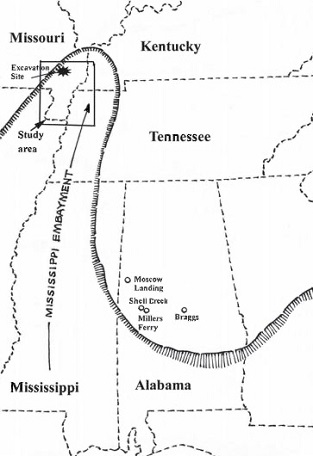
Generalized map of the southeast coastal region at the time of the Chicxulub impact
Map courtesy of Campbell et al., ‘The Sedimentary Record of Impacts’, GSA Special Paper 437, pp. 189–198 (2008) The K–Pg boundary site closest to the Chicxilub crater is located in the Orange Walk District in northern Belize, and this is the only known direct ejecta deposit, or fluidized debris flow (D.T. King Jr, 1996). The outcrop at Albion Quarry has a thickness of 16 m and contains material ranging in size from finely-ground host matrix to boulders 8 m in diameter that were ejected from the crater during impact. The stratigraphy of this quarry includes a 1–2 m basal Type 2 spherule-bearing layer in direct contact with the Maastrichtian Barton Creek Dolomite bedrock, which is overlain by an ~14-m-thick, poorly sorted diamictite layer comprised of several roughly graded beds. Pebble-sized red and green clay clasts within the diamictite layer are likely altered glass fragments (Ocampo et al., 1996). In the basal layer, the spherules exhibit increased flattening towards the bottom of the bed. Pope and Ocampo (2000) described large, sub-rounded, extremely fine-grained limestone fragments (~4–23 cm in diameter) known as Pook’s pebbles found at Pook’s Hill in western Cayo District. These pebbles exhibit several features indicative of sub-orbital flight and ablationGradual removal of the successive surface layers of a material through various processes. • The gradual removal and loss of meteoritic material by heating and vaporization as the meteoroid experiences frictional melting during its passage through the atmosphere. The resulting plasma ablates the meteor and, in cases where a meteor Click on Term to Read More during atmospheric re-entry, including regmaglypts, impact and ablative pits, parallel gouges and striations, rounded facets, and thin, translucent, relict fusion crustMelted exterior of a meteorite that forms when it passes through Earth’s atmosphere. Friction with the air will raise a meteorite’s surface temperature upwards of 4800 K (8180 °F) and will melt (ablate) the surface minerals and flow backwards over the surface as shown in the Lafayette meteorite photograph below. Click on Term to Read More (often truncated and located opposite a heavily pitted side, indicative of orientation); these pebbles are analogous to terrestrial meteorites (see photo below). Although to date no impact glass or shocked grains have been found at the western Cayo District site, Pope et al. (2005) did describe impact ejecta material such as spherules, altered glass shards, and shocked quartz from an outcrop at Armenia in the eastern Cayo District; notably, Armenia and Pook’s Hill are equidistant from the crater, and therefore it could be inferred that both locations should contain similar deposits from the ejecta curtain and/or impact vapor plume.

Pook’s pebble with impact craterCrater formed by high-speed impact of a meteoroid, asteroid, or comet on a solid surface. Craters are a common feature on most moons (an exception is Io), asteroids, and rocky planets, and range in size from a few cm to over 1,000 km across. There is a general morphological progression Click on Term to Read More and thin fusionProcess in which two lighter atomic nuclei combine to form a heavier atomic nucleus. Very high temperatures are normally required in order for atomic nuclei to collide with sufficient energy to overcome the Coulomb barrier (their mutual electrostatic repulsions). Fusion that occurs under high-temperature conditions is called thermonuclear fusion. Fusion Click on Term to Read More crustOutermost layer of a differentiated planet, asteroid or moon, usually consisting of silicate rock and extending no more than 10s of km from the surface. The term is also applied to icy bodies, in which case it is composed of ices, frozen gases, and accumulated meteoritic material. On Earth, the Click on Term to Read More
Photo credit: A.C. Ocampo and K.O. Pope, Planetary Report, vol. 16, p. 9 © Planetary Society,
courtesy of David T. King Jr, 1996—Cretaceous–Tertiary Boundary Stratigraphy Web Page Impact spherules from the distal K–Pg boundary sections of the Umbria-Marche region in Italy were studied by Belza et al. (2017). It was ascertained that they are Type 2 spherules representing vaporized impactor (chondritic) and target (both sedimentary carbonate platform and crystalline granitic basement rock types) material which condensed out of the globally expanding impact vapor plume. They occur in relatively high concentrations (up to 200 per cm³) embedded in a thin layer (1–3 cm) of reddish clay demarking the K–Pg boundary. These Type 2 spherules measure 0.05–0.4 mm (ave. 0.25 mm) in size, which is significantly smaller than proximal Type 1 spherules. As with spherules from all locations, those from the Umbria-Marche region were initially emplaced into a marine environment at significant depth where alteration progressed for an extended period of time. The Umbria-Marche spherules have been categorized by Belza et al. (2017) into three distinct types based on texture and composition: 1) goethite, 2) K-feldspar, and 3) glauconite.
- It was determined that the black goethite spherules are a product of primary olivineGroup of silicate minerals, (Mg,Fe)2SiO4, with the compositional endpoints of forsterite (Mg2SiO4) and fayalite (Fe2SiO4). Olivine is commonly found in all chondrites within both the matrix and chondrules, achondrites including most primitive achondrites and some evolved achondrites, in pallasites as large yellow-green crystals (brown when terrestrialized), in the silicate portion Click on Term to Read More replacement under aqueous conditions. They contain very high abundances of refractory lithophile and siderophile elements consistent with early fractional condensation from a high-temperature region of the vapor plume. Belza et al. (2017) observed that these spherules preserve relict crystal textures analogous to several meteoriteWork in progress. A solid natural object reaching a planet’s surface from interplanetary space. Solid portion of a meteoroid that survives its fall to Earth, or some other body. Meteorites are classified as stony meteorites, iron meteorites, and stony-iron meteorites. These groups are further divided according to their mineralogy and Click on Term to Read More chondruleRoughly spherical aggregate of coarse crystals formed from the rapid cooling and solidification of a melt at ~1400 ° C. Large numbers of chondrules are found in all chondrites except for the CI group of carbonaceous chondrites. Chondrules are typically 0.5-2 mm in diameter and are usually composed of olivine Click on Term to Read More types, including porphyritic, radial/barred, relict/granular, skeletal, and barred. They concluded that the specific texture of the spherules was controlled by peak temperature, heating duration, cooling rate, and degree of undercooling, the latter related to the availability of nucleation sites within melt droplets as influenced by unmelted precursor grains or variable concentrations of dust in the vapor plume.
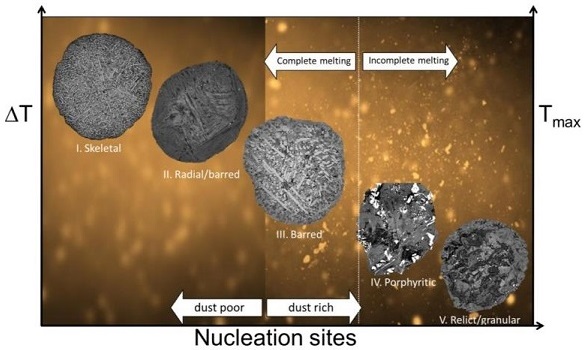
Image credit: Belza et al., GCA, vol. 202, p. 251 (2017)
‘Petrography and geochemistryStudy of the chemical composition of Earth and other planets, chemical processes and reactions that govern the composition of rocks and soils, and the cycles of matter and energy that transport Earth's chemical components in time and space. Click on Term to Read More of distal spherules from the K-Pg boundary in the Umbria-Marche region (Italy)
and their origin as fractional condensates and melts in the Chicxulub impact plume’
(http://dx.doi.org/10.1016/j.gca.2016.12.018)
- Moreover, Belza et al. (2017) ascertained that the white K-feldspar and calcite spherules are aqueous replacement products of primary pyroxeneA class of silicate (SiO3) minerals that form a solid solution between iron and magnesium and can contain up to 50% calcium. Pyroxenes are important rock forming minerals and critical to understanding igneous processes. For more detailed information, please read the Pyroxene Group article found in the Meteoritics & Classification category. Click on Term to Read More and plagioclaseAlso referred to as the plagioclase feldspar series. Plagioclase is a common rock-forming series of feldspar minerals containing a continuous solid solution of calcium and sodium: (Na1-x,Cax)(Alx+1,Si1-x)Si2O8 where x = 0 to 1. The Ca-rich end-member is called anorthite (pure anorthite has formula: CaAl2Si2O8) and the Na-rich end-member is albite Click on Term to Read More, respectively. These spherules are considered to have experienced varying degrees of supercooling and nucleation delay within a fractionated, cooler region of the vapor plume than the goethite spherules. In addition, they proposed that the green glauconite spherules probably formed through the transformation of smectite by K uptake in a marine environment associated with low pH and abundant organicPertaining to C-containing compounds. Organic compounds can be formed by both biological and non-biological (abiotic) processes. Click on Term to Read More matter, while the smectite could be the initial replacement product of quenched basaltic glass akin to the proximal Type 1 spherules. The source for the green glauconite spherules would be those melt droplets ejected at the steepest angles to become entrained in the expanding vapor plume.
Core samples from the central peakExposed core of uplifted rocks in center of a complex impact crater. Central peak material typically shows evidence of intense fracturing, faulting, and shock metamorphism. Click on Term to Read More of the Chicxulub crater were obtained in 2016 and are now under analyses at the International Ocean Discovery Program (IODP) Bremen CoreIn the context of planetary formation, the core is the central region of a large differentiated asteroid, planet or moon and made up of denser materials than the surrounding mantle and crust. For example, the cores of the Earth, the terrestrial planets and differentiated asteroids are rich in metallic iron-nickel. Click on Term to Read More Repository in Germany. The K-Pg boundary sample shown above is from Beloc, Haiti and weighs 0.35 g. It consists of mm-scale spherules and black glass fragments in a limestone matrix.
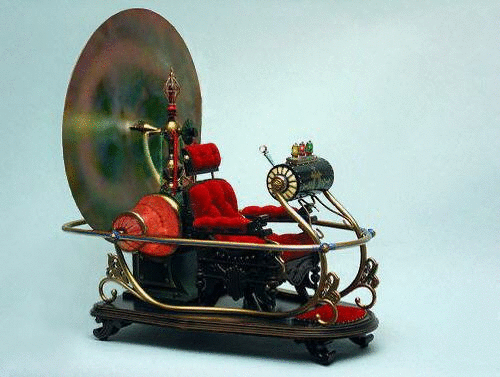
mouseover the time machine set to 66.038 m.y. before present ‘The Day The Mesozoic Died’, from Howard Hughes Medical Institute—on Vimeo

Illustration credit: Don Davis (NASA)






